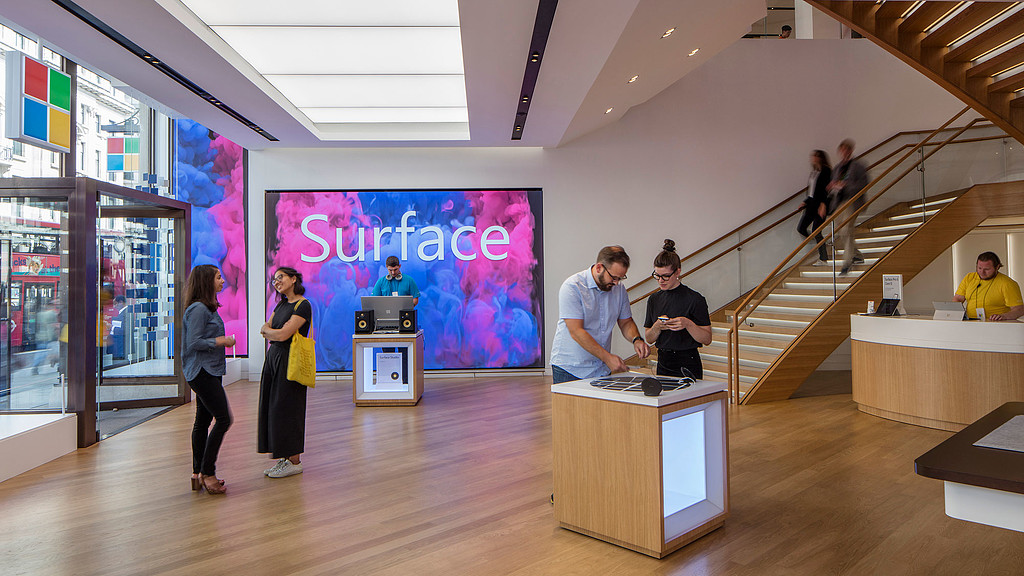Unlocking What’s Next for Consumer Experiences
November 23, 2021 | By Lara Marrero, Aaron Birney, and voices from Gensler's Global Consumer Experiences & Retail team
Editor’s Note: This blog is part of our Design Forecast blog series, looking at what’s next in 2022 and beyond.
As we look ahead to 2022 and beyond, it’s time for brands to look past their business livelihoods and to set their sights on offering consumer experiences that will turn challenges into competitive advantages.
We asked some of our global retail and experience design leaders, “What are the future opportunities that brands should consider when designing retail/consumer experiences, both in the short-term and long-term?”
Here’s a look at some of their responses, and some common themes for what lies ahead for consumer experiences:
Resilience, ethics, and sustainability come to the fore.
“In a time of environmental crisis, audiences, particularly younger generations, are seeking out brands with values that align with their own.”
—Andy Piepenstock, design director, Gensler London
“As the circular economy becomes more and more prevalent, brands will need to examine how sustainability can drive new ways of interacting with customers.”
—Kathleen Allen, design strategist, Gensler Atlanta
“Consumers (especially younger generations) are expecting brands to have similar values and ethics when it comes to making a purchase decision. Those brands that are successful today tend to have strong community development programs that are active and visible.”
—Christian Castro, regional retail leader, Latin America
“Going beyond simple greenwashing to gain trust of customers who care about sustainability of materials, but also traceability of materials, whole product lifecycles, and giving back to the planet.”
—Elliott Mitchell, interior designer, Gensler London
“Eco-friendly and sustainable brand space is very much the future. As conscious consumption continues to grow, open-source and hands-on design techniques will make their way into the home.”
—Isa Cashmore, designer, Gensler London
Digital and physical will continue to seamlessly blend.
“Designed together, live customer data connects digital and physical transactions in real time. Customer Experience (CX) tweaks and changes are made daily and become automated by sophisticated retail AI.”
—Hans Neubert, creative director of digital experience design
“Many clients are looking at ways to automate things like the service experience with apps, kiosks, etc. There’s the option of speaking to a live person or engaging the app or a kiosk with a person nearby to help (like grocery store self-check-out). This has the potential to meet the customer where they want to be, which is not necessarily talking to a service advisor.”
—Josh Keough, regional retail leader, North Central
“Stores in China are increasingly linking sales activities in-store to online activities. Increasingly, Gen Z consumers are simultaneously shopping online while in-store, checking for the best deals on digital platforms while testing the product in store. The question we face now is how to leverage this duality in retail design.”
—Michael Green, interior designer, Gensler Shanghai
“A brand should have a holistic approach to the ‘places’ where it comes to life, both virtually and physically. A consistent framework should allow for unique experiences that are site specific and connected digitally across the community of customers, online and in store.”
—John Bricker, creative director, Gensler New York
“Creating more seamless connections and bridging the gap between the in-store retail experience and digital / post-shopping experience so that brands stay top-of-mind for consumers.”
—Vania Lin, graphic designer, Gensler Atlanta
Integration of AR, VR, and MR will create more immersive experiences.
“Augmented Reality (AR) is enhancing the physical experience and creating an experiential overlay. Virtual Reality (VR) is bridging the digital and physical and bringing the physical experience into the home.”
—Andy Piepenstock, design director, Gensler London
Brands will increasingly expand into the metaverse.
“Brands like Louis Vuitton, Burberry, Balenciaga, Versace, and Gucci have expanded into the metaverse, designing apps, games, and more. NFTs (non-fungible tokens) are low overhead, can be verified for authenticity, good ROI, and can be packaged with the purchase of physical goods. Brands might want to explore whether there’s an appetite to showcase NFTs in physical space.”
—Alexia Beghi, architect, Gensler New York
“Many luxury brands are now using digital spaces to explore products and spaces in a game-like fashion. Brands from Gucci to Balenciaga and Prada are experimenting with this, from a simultaneous 3D video game experience combined with a traveling exhibition, to customizable outfits in video games, to digital VR pop-up walkthroughs. This increasing physical/digital presence is sure to trickle down from luxury brands to other levels of retail.”
—Michael Green, interior designer, Gensler Shanghai
Community building will be critical to brand presence.
“To resonate with audiences, brands should focus on creating a brand message and style that consumers can get behind, share with friends, and want to become a part of. This can be further backed up by creating retail locations that double up as ‘clubhouses’ where further brand loyalty and tribal following can be nurtured.”
—Elliott Mitchell, interior designer, Gensler London
Stores will become platforms for livestream events.
“There’s been an uptick of retail spaces considering aspects of livestream events. Some stores have dedicated booths or backdrops that can be used for online sales or even non-sales platforms. These spaces can drive new product launch sales but also drive brand building and create a community presence for brands. Whether an actual ‘stage set’ with light and sound capabilities or just a dramatically designed background, the key is that the store itself is now being the host for these activities.”
—Michael Green, interior designer, Gensler Shanghai
Quick, on-demand merchandise delivery is now expected.
“A big thing we’re seeing in automotive is a reliance on ordering and quick delivery of merchandise, and not keeping gobs of inventory on site. This now includes vehicles themselves. Ford has launched the first salvo with discounts to customers who order and wait for their vehicle, thereby reducing the dealer’s costs for additional land, financing lots full of cars, etc. They’re trying to get dealers from 60-75-day supplies of vehicles down to below 50. (That is, when there are supplies of cars again, of course.)”
—Josh Keough, regional retail leader, North Central
“Consumers have gotten used to the convenience of near-instantaneous delivery. Many people are still working from home and are able to receive packages, food deliveries, and even COVID tests in real time. Brands like Apple, MAC Cosmetics, and Sephora are using services like Postmates or Instacart for same-day delivery. This trend will continue post-pandemic.”
—Alexia Beghi, architect, Gensler New York
Blended spaces, cobranding, and smart partnerships.
“While the concept of blended spaces isn’t new (think gyms and juice bars, bookstores and coffee, etc.), the rise of branded hotels is allowing consumers to test and try products that are also sold on site. The development of retailer-to-retailer partnerships is also important to consider where providers can collaborate to create a purposeful blended retail experience.”
—Alexia Beghi, architect, Gensler New York
“Banking, coworking, and cafés are combining — this is reshaping how banks interact with their customer base.”
—Jonathan Tyler, regional retail leader, Northeast
Brands should address ‘skimpflation’ and supply chain transparency.
“Inventory transparency, supply chain uncertainty, and timing of product availability seems to be a consumer hot point across all categories. How can design solve these questions and assure customers that they’ll be quickly gratified when they make a purchase?”
—Barry Bourbon, regional retail leader, Northwest
“Retailers are implementing new industry 4.0 manufacturing approaches to offer better environmentally-conscious products and services. Smarter, smaller factories and distribution are localized with short distance to customers. This becomes part of the retail story.”
—Hans Neubert, creative director of digital experience design
Be local, personal, and stay relevant.
“Be local and stay relevant — see where the outlet is and create a relevant destination for the community.”
—Markus Pesendorfer, regional retail leader, Asia Pacific Middle East
“The diversity within the retail space and curatorship of it should be as important as the mix outside of it. This is very unique to place and should manifest very differently in different locations. Local knowledge, culture, and personality are key factors. Adjacency with similar target demographics is also important.”
—Jonathan Tyler, regional retail leader, Northeast
“There’s an opportunity for brands to be more experimental, local, and personal.”
—Andy Piepenstock, project director, Gensler London
For media inquiries, email .


